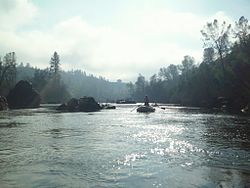| South Fork American River | |
|---|---|
 | |
 | |
| Location | |
| Country | United States |
| State | California |
| Physical characteristics | |
| Source | |
| • location | Sierra Nevada |
| • coordinates | 38°48′38″N 120°01′52″W / 38.81056°N 120.03111°W[1] |
| Mouth | |
• location | Folsom Lake |
• coordinates | 38°44′03″N 121°06′15″W / 38.73417°N 121.10417°W[1] |
• elevation | 466 ft (142 m) |
| Length | 87 mi (140 km)[2] |
| Basin size | 840 sq mi (2,200 km2)[4] |
| Discharge | |
| • average | 1,458 cu ft/s (41.3 m3/s)[3] |
| Basin features | |
| Progression | American–Sacramento |
The South Fork American River is a major tributary of the American River in El Dorado County, California,[1] draining a watershed on the western slope of the Sierra Nevada east of Sacramento. The river begins in pristine Desolation Wilderness and flows through the Sierra Nevada foothills. The river at Coloma was the site of James Marshall's discovery of gold at Sutter's Mill on January 24, 1848, which started the California Gold Rush.[5] The South Fork of the American is "the most popular recreation stream in the West" for whitewater rafting in North America,[6] e.g., 80,000 visitors in 2011.[7] Professional whitewater rafting companies have been offering commercial rafting trips on the South Fork American River since 1978.
- ^ a b c "South Fork American River". Geographic Names Information System. United States Geological Survey, United States Department of the Interior. 1981-01-19. Retrieved 2013-04-14.
- ^ Cite error: The named reference
NHDwas invoked but never defined (see the help page). - ^ Cite error: The named reference
NWISwas invoked but never defined (see the help page). - ^ Cite error: The named reference
watershedwas invoked but never defined (see the help page). - ^ "South Fork of the American River". The American River: California's favorite whitewater river. Retrieved 2013-04-14.
- ^ McHugh, Paul (April 11, 2011). "California whitewater rafting: Season's on for 2014 (drought or not)". San Jose Mercury. Retrieved December 2, 2018.
- ^ Branan, Brad (April 22, 2017). "Record snowpack makes for wild whitewater rafting on American River". Sacramento Bee. Retrieved December 2, 2018.